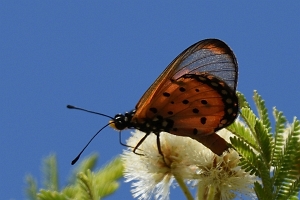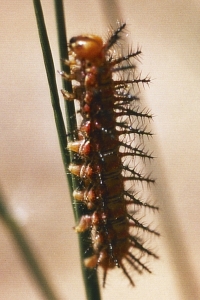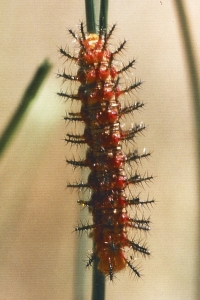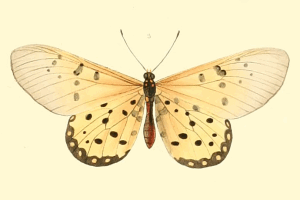Inhalt
1. Lebendfotos
1.1. Falter
1: Swasiland, Hlane-Royal-Nationalpark, ca. 280 m, 9. Dezember 2018 (det. & fot.: Peter Ginzinger)Forum
1.2. Raupe
2. Diagnose
2.1. Erstbeschreibung
1-3: Doubleday ([1847]: 140, pl. XIX fig. 3) [nach Copyright-freien Scans auf www.biodiversitylibrary.org]
3. Weitere Informationen
3.1. Synonyme
- Acraea seis Feisthamel, 1850 [Synonym nach funet.fi]
- Acraea calyce Goldman & Salvin, 1884 [Synonym nach funet.fi]
- Acraea mhondana Vuillot, 1891 [Synonym nach funet.fi]
- Acraea arabica Rebel, 1899 [Synonym nach funet.fi]
- Acraea zambesina Aurivillius, 1909 [Synonym nach funet.fi]
3.2. Unterarten
- Acraea neobule legrandi Carcasson, 1964 [Unterart nach funet.fi]
3.3. Faunistik
Nach [Global Biodiversity Information Facility] kommt die Art in Südafrika, Kenia, Ghana, Namibia, Tansania, Botswana, Swasiland, Sambia, Kamerun, Komoren, Simbabwe, Mosambik, Seychellen, Benin, Demokratische Republik Kongo, Mayotte, Angola, Zentralafrikanische Republik, Kongo, Elfenbeinküste, Äthiopien, Mali, Uganda, Jemen, Liberia, Madagaskar, Malawi, Nigeria, Burundi, Eritrea, Guinea, Sudan, Sierra Leone, Senegal und Südsudan vor.
Locus typicus gemäß Erstbeschreibung: Congo.
(Autor: Michel Kettner)
3.4. Literatur
- Erstbeschreibung: Doubleday, E. & J. O. Westwood (1846-1850): The Genera of Diurnal Lepidoptera: Comprising their Generic Characters, a Notice of their Habits and Transformations, and a Catalogue of the Species of each Genus 1: i-xii, 1-250, explanation of the plates of details, pl. A, pl. I, I*, II-IV, IV*, V-XXX. London (Longman, Brown, Green, and Longmans).




![Vorkommen in Saudi-Arabien [Verovnik, Kosmač, Ishag, Al Dhafer & Seizmair (2024)]](/res/img/flag/sa.gif)
![Vorkommen in Jemen [Global Biodiversity Information Facility]](/res/img/flag/ye.gif)
![Vorkommen in Oman [Verovnik, Seizmair, Hula, Mráček & Fric (2022)]](/res/img/flag/om.gif)
![Vorkommen in Mali [Global Biodiversity Information Facility]](/res/img/flag/ml.gif)
![Vorkommen in Sudan [Global Biodiversity Information Facility]](/res/img/flag/sd.gif)
![Vorkommen in Südsudan [Global Biodiversity Information Facility]](/res/img/flag/ss.gif)
![Vorkommen in Eritrea [Global Biodiversity Information Facility]](/res/img/flag/er.gif)
![Vorkommen in Äthiopien [Global Biodiversity Information Facility]](/res/img/flag/et.gif)
![Vorkommen in Senegal [Global Biodiversity Information Facility]](/res/img/flag/sn.gif)
![Vorkommen in Guinea [Global Biodiversity Information Facility]](/res/img/flag/gn.gif)
![Vorkommen in Sierra Leone [Global Biodiversity Information Facility]](/res/img/flag/sl.gif)
![Vorkommen in Liberia [Global Biodiversity Information Facility]](/res/img/flag/lr.gif)
![Vorkommen in Elfenbeinküste [Global Biodiversity Information Facility]](/res/img/flag/ci.gif)
![Vorkommen in Ghana [Global Biodiversity Information Facility]](/res/img/flag/gh.gif)
![Vorkommen in Benin [Global Biodiversity Information Facility]](/res/img/flag/bj.gif)
![Vorkommen in Nigeria [Global Biodiversity Information Facility]](/res/img/flag/ng.gif)
![Vorkommen in Kamerun [Global Biodiversity Information Facility]](/res/img/flag/cm.gif)
![Vorkommen in der Zentralafrikanischen Republik [Global Biodiversity Information Facility]](/res/img/flag/cf.gif)
![Vorkommen in der Republik Kongo [Global Biodiversity Information Facility]](/res/img/flag/cg.gif)
![Vorkommen in der Demokratischen Republik Kongo [Global Biodiversity Information Facility]](/res/img/flag/cd.gif)
![Vorkommen in Uganda [Global Biodiversity Information Facility]](/res/img/flag/ug.gif)
![Vorkommen in Kenia [Global Biodiversity Information Facility]](/res/img/flag/ke.gif)
![Vorkommen in Burundi [Global Biodiversity Information Facility]](/res/img/flag/bi.gif)
![Vorkommen in Tansania [Global Biodiversity Information Facility]](/res/img/flag/tz.gif)
![Vorkommen in Angola [Global Biodiversity Information Facility]](/res/img/flag/ao.gif)
![Vorkommen in Sambia [Global Biodiversity Information Facility]](/res/img/flag/zm.gif)
![Vorkommen in Malawi [Global Biodiversity Information Facility]](/res/img/flag/mw.gif)
![Vorkommen in Mosambik [Global Biodiversity Information Facility]](/res/img/flag/mz.gif)
![Vorkommen in Namibia [Foto im Forum]](/res/img/flag/na.gif)
![Vorkommen in Botswana [Global Biodiversity Information Facility]](/res/img/flag/bw.gif)
![Vorkommen in Simbabwe [Global Biodiversity Information Facility]](/res/img/flag/zw.gif)
![Vorkommen in Südafrika [Global Biodiversity Information Facility]](/res/img/flag/za.gif)
![Vorkommen in Eswatini [Foto im Forum]](/res/img/flag/sz.gif)
![Vorkommen auf Madagaskar [Global Biodiversity Information Facility]](/res/img/flag/mg.gif)
![Vorkommen auf den Komoren [Global Biodiversity Information Facility]](/res/img/flag/km.gif)
![Vorkommen in Mayotte [Global Biodiversity Information Facility]](/res/img/flag/yt.gif)
![Vorkommen auf den Seychellen [Global Biodiversity Information Facility]](/res/img/flag/sc.gif)






